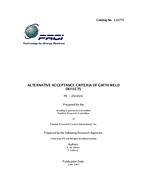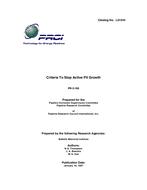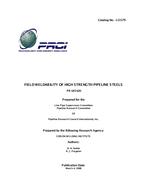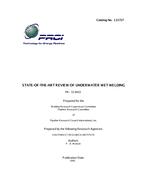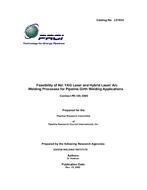Provide PDF Format
PRCI PR-202-9328
- Alternative Acceptance Criteria of Girth Weld Defects.
- Report / Survey by Pipeline Research Council International, 06/01/1997
- Publisher: PRCI
$448.00$895.00
L51771e
RESEARCH_AGENCYUniversity of Gent-Belgian Welding Institute
Need: The girth weld defect acceptance standards based on good workmanship reflect quality levels that can be reasonably expected from a qualified welder. Workmanship (WM) or weld quality standards specify a maximum allowable length whilst the percentage loss of cross-sectional area is used for porosities. This approach to defect acceptance philosophy has arisen from the use of radiography as the NDE technique for detecting and quantifyingweld discontinuities. The first WM standard for inspection and acceptance of finished girth welds was implemented by API in 1953. The specific requirements of the 1953-standard were largely based on the "Unfired Pressure Vessel Code" which was first adopted by ASME in 1931. Since then, a number of slightly revised standards were issued to reflect what should be attainable with normal good welding practices.
Result: The failure behaviour of defective girth welds in large diameter pipe lines was assessed using radiographic and mechanized ultrasonic inspection, small scale (tensile, hardness, Charpy and CTOD) and wide plate tests. The specimens were taken from girth welds in API 5LX70 pipe of 1219 mm (48 inches) in diameter by 8,0 mm (0,323 inch) and 13,3 mm (0,524 inch) wall. The test welds were made with the SMAW (8 welds) and GMAW (9 welds) welding processes.
Benefit: Upon completion of the non-destructive tests, 96 curved wide plate specimens were tested to destruction under tensile load. Testing was performed at low temperature (-50°C/-58°F). Defect type, defect position and size were determined from photographs of the fracture face and macro sections (defect characterization and sizing). In total, 290 typical surface breaking and embedded defects in SMAW or GMAW girth welds have been evaluated. The vast majority of these defects were grossly out of tolerance with respect to current weld quality (workmanship) acceptance levels.
RESEARCH_AGENCYUniversity of Gent-Belgian Welding Institute
Need: The girth weld defect acceptance standards based on good workmanship reflect quality levels that can be reasonably expected from a qualified welder. Workmanship (WM) or weld quality standards specify a maximum allowable length whilst the percentage loss of cross-sectional area is used for porosities. This approach to defect acceptance philosophy has arisen from the use of radiography as the NDE technique for detecting and quantifyingweld discontinuities. The first WM standard for inspection and acceptance of finished girth welds was implemented by API in 1953. The specific requirements of the 1953-standard were largely based on the "Unfired Pressure Vessel Code" which was first adopted by ASME in 1931. Since then, a number of slightly revised standards were issued to reflect what should be attainable with normal good welding practices.
Result: The failure behaviour of defective girth welds in large diameter pipe lines was assessed using radiographic and mechanized ultrasonic inspection, small scale (tensile, hardness, Charpy and CTOD) and wide plate tests. The specimens were taken from girth welds in API 5LX70 pipe of 1219 mm (48 inches) in diameter by 8,0 mm (0,323 inch) and 13,3 mm (0,524 inch) wall. The test welds were made with the SMAW (8 welds) and GMAW (9 welds) welding processes.
Benefit: Upon completion of the non-destructive tests, 96 curved wide plate specimens were tested to destruction under tensile load. Testing was performed at low temperature (-50°C/-58°F). Defect type, defect position and size were determined from photographs of the fracture face and macro sections (defect characterization and sizing). In total, 290 typical surface breaking and embedded defects in SMAW or GMAW girth welds have been evaluated. The vast majority of these defects were grossly out of tolerance with respect to current weld quality (workmanship) acceptance levels.
Related Products
PRCI PR-185-0005
Feasibility of Nd-YAG Laser & Hybrid Laser/Arc Welding Processes for Pipeline Girth Welding Appl..
$198.00 $395.00

